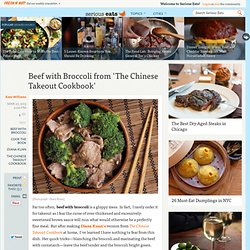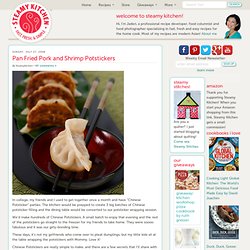

Fuchsia Dunlop's Zhajiang Noodles (Zha Jiang Mian) [Photograph: Chris Terry] Noodles are eaten at least a couple times a week at my house.

Usually they're not eaten with much grandeur—a brothy soup full of rice stick here, a quick veg-heavy sauce atop egg noodles there—but they're still a favorite easy dinner. Fuchsia Dunlop's Zhajiang Noodles from her new cookbook Every Grain of Rice were thus a welcome new dinner. The sauce is a thick, savory concoction of ground pork belly and sweet fermented sauce (tianmianjiang)—almost blindingly salty on its own, but mellowed when tossed with the mild wheat noodles and assorted blanched vegetables.
Why I picked this recipe: Looking for a one-dish noodle meal, I picked this vegetable-heavy dish because it used pork to enhance, rather than dominate the meal. Fuchsia Dunlop's Twice-Cooked Swiss Chard (Hui Gua Niu Pi Cai) [Photograph: Chris Terry] Chard is a mainstay in my kitchen during the long winter months.

The fast-cooking greens are chock full of vitamins to counteract all of that rich comfort food. But even a tender green such as chard gets dull as we wait for the exciting vegetables of spring. Leave it to Fuchsia Dunlop to reinvigorate chard by treating it like pork. In Every Grain of Rice, Dunlop presents an array of recipes using chard and other leafy greens, but it was the twice-cooked recipe that really caught my eye.
Why I picked this recipe: I've eaten my fair share of twice-cooked pork at my favorite Chinese restaurants, so I was eager to apply these flavors to one of my favorite winter greens, swiss chard. What worked: Once again, everything was on point. What didn't: Nothing; you may find it strange (as I did) to blanch the greens in unsalted water, but the intense saltiness of the sauce more than makes up for the lack of seasoning in the blanching water. Hot and Sour Soup from 'Stewed' [Photograph: Nina Gallant] Is it just me or is hot and sour soup one of the weirdest in the Chinese take-out canon?

Most bowls consist of a gloppy mass of orange sweet liquid, giving way to a slightly sour and slightly spicy finish. Bites of mushroom, pea, and tofu add a bit of interest, but they can't save the soup bowl. But there's no reason why a homemade bowl of hot and sour can't make for a warming, pleasant meal. Dave Becker's recipe in Stewed is one such example.
Scallion Pancakes recipe from Food52. Author Notes: Sconegirl and I have been trying to recreate scallion pancakes at home.

Every time we eat at a Chinese restaurant, we always order them. We were pretty happy with the way these turned out. Adapted from my recipe for Nonna's Piadina and most of the techniques of scallion pancake-rolling on the internet. Beef with Broccoli from 'The Chinese Takeout Cookbook' [Photograph: Diana Kuan] Far too often, beef with broccoli is a gloppy mess.

In fact, I rarely order it for takeout as I fear the curse of over-thickened and excessively-sweetened brown sauce will ruin what would otherwise be a perfectly fine meal. But after making Diana Kuan's version from The Chinese Takeout Cookbook at home, I've learned I have nothing to fear from this dish. Her quick tricks—blanching the broccoli and marinating the beef with cornstarch—leave the beef tender and the broccoli bright green. The sauce? Scallion Pancakes from 'The Chinese Takeout Cookbook' [Photograph: Ethan Finkelstein] Scallion pancakes are definitely in that category of "easier-to-make-than-you-think" foods.

All those flaky layers point towards hours of work and folding (like homemade croissants or puff pastry), but in reality these babies can come together in no time. Diana Kuan's scallion pancakes in The Chinese Takeout Cookbook are a prime example. A simple dough of flour and water just needs a few minutes of kneading to turn supple; after a short rest, the dough is ready to be filled and rolled into miniature savory cakes. The secret to all of the layers? Secrets to Cooking the Best Chinese Fried Rice. Monday, April 9, 2007 Fried Rice is the Chinese version of casserole.

Basically, its a great way to use up leftover bits in the refrigerator. My ingredients change based on what vegetables and meat I have on hand. The only 3 constants are: 1) Rice 2) Fish Sauce 3) Chinese Sausage “Lap Cheong” The above photo includes 1/4 of a red bell pepper, frozen peas/carrots, 2 eggs, 1/4 of a red onion, lap cheong (Chinese sausage). Secret #1: The Rice Just freshly cooked rice is hot, steamy, very moist and a little sticky.
Secret #2: The Fish Sauce Many of my non-Asian friends will respond with “ewwwww…..fish sauce?” A sign of good fish sauce is the color. Secret #3: The Chinese Sausage It’s like pancetta in Italian cooking, where you render the fat (a.k.a. low heat and melt the fat). Secret #4: The Heat Once you add your rice to the wok, crank up the heat to high. Secret #5: Storing and Re-heating Store leftover fried rice tightly covered in the refrigerator. Pan Fried Pork and Shrimp Potstickers. Sunday, July 27, 2008 Pan Fried Pork and Shrimp Potstickers In college, my friends and I used to get together once a month and have “Chinese Potsticker” parties.

The kitchen would be prepped to create 3 big batches of Chinese potsticker filling and the dining table would be converted to our potsticker wrapping session. We’d make hundreds of Chinese Potstickers. A small batch to enjoy that evening and the rest of the potstickers go straight to the freezer for my friends to take home.
Taiwan. Misc. Duck. Vegetables. Chicken. Pork.